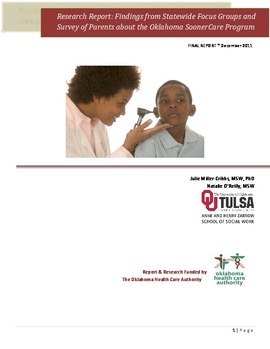| dc.description.abstract | Research has documented that the loss of health insurance has a detrimental impact on the health of children, often due to fewer well-child visits and preventative medicine. Even temporary gaps in health insurance coverage have a negative effect on children’s health; therefore retention of children in Medicaid programs is vital to maintaining their health and wellness. Re-enrollment and retention of children already enrolled in Medicaid programs is a significant challenge for states, but is an important factor in reducing the number of uninsured children. Oklahoma is a state with significant health challenges, ranking 50th in the overall health of its citizens (Commonwealth Fund, 2009). Minority groups experience higher rates of poverty, and are more likely to be without health insurance; Hispanic children in Oklahoma are four times more likely to be uninsured than African American children, and Native American children also have a high rate of being uninsured. Teenagers are at a higher risk of being uninsured in Oklahoma than younger children.Oklahoma’s Medicaid program seeks to provide comprehensive health coverage to all eligible children in the state and to reduce gaps in coverage. The Oklahoma Health Care Authority has adopted a 12-month eligibility cycle, where enrolled children are provided with continuous eligibility for a year, without any re-enrollment requirements for the family during that time period. When utilizing the Oklahoma Health Care Authority’s website to apply for Medicaid, families are able to update their member information (such as address, phone numbers, or income levels) online; each time a member updates their information, the 12 month eligibility resets from that date. This report discusses findings of a statewide survey of parents with children currently enrolled in, eligible for but not enrolled, or previously enrolled but had not re-enrolled in Oklahoma’s SoonerCare program. The study consisted of two major components: regional focus groups and a statewide survey of parents. Mixing both quantitative and qualitative methods to get rich, detailed and statewide responses, researchers examined a range of questions regarding SoonerCare enrollee’s thoughts on re-enrollment practices, program benefits and deficits, and feelings of security in their coverage. This research seeks to understand the major barriers and challenges that SoonerCare participants face in retaining consistent coverage for their children. The final section of the report offers conclusions and implications of this research. | en_US |
